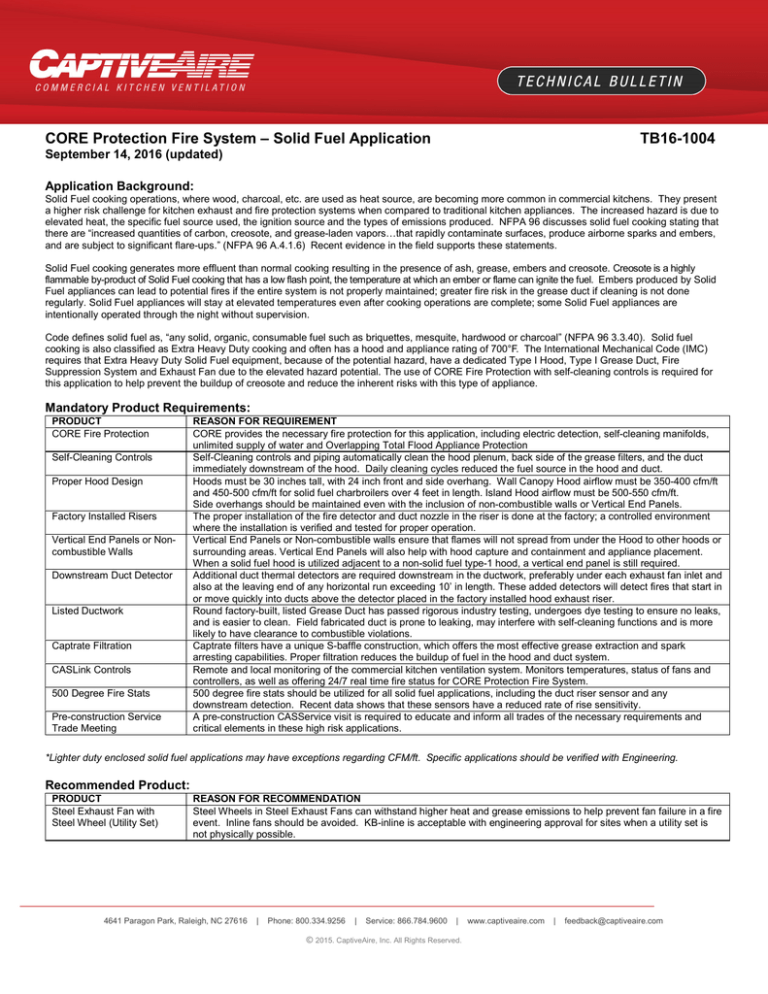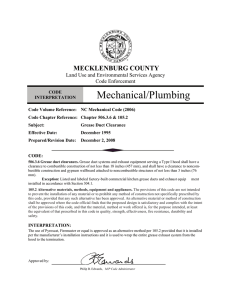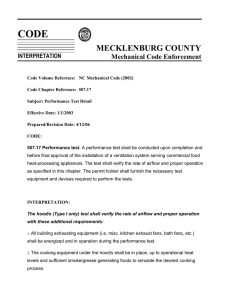
CORE Protection Fire System – Solid Fuel Application
TB16-1004
September 14, 2016 (updated)
Application Background:
Solid Fuel cooking operations, where wood, charcoal, etc. are used as heat source, are becoming more common in commercial kitchens. They present
a higher risk challenge for kitchen exhaust and fire protection systems when compared to traditional kitchen appliances. The increased hazard is due to
elevated heat, the specific fuel source used, the ignition source and the types of emissions produced. NFPA 96 discusses solid fuel cooking stating that
there are “increased quantities of carbon, creosote, and grease-laden vapors…that rapidly contaminate surfaces, produce airborne sparks and embers,
and are subject to significant flare-ups.” (NFPA 96 A.4.1.6) Recent evidence in the field supports these statements.
Solid Fuel cooking generates more effluent than normal cooking resulting in the presence of ash, grease, embers and creosote. Creosote is a highly
flammable by-product of Solid Fuel cooking that has a low flash point, the temperature at which an ember or flame can ignite the fuel. Embers produced by Solid
Fuel appliances can lead to potential fires if the entire system is not properly maintained; greater fire risk in the grease duct if cleaning is not done
regularly. Solid Fuel appliances will stay at elevated temperatures even after cooking operations are complete; some Solid Fuel appliances are
intentionally operated through the night without supervision.
Code defines solid fuel as, “any solid, organic, consumable fuel such as briquettes, mesquite, hardwood or charcoal” (NFPA 96 3.3.40). Solid fuel
cooking is also classified as Extra Heavy Duty cooking and often has a hood and appliance rating of 700°F. The International Mechanical Code (IMC)
requires that Extra Heavy Duty Solid Fuel equipment, because of the potential hazard, have a dedicated Type I Hood, Type I Grease Duct, Fire
Suppression System and Exhaust Fan due to the elevated hazard potential. The use of CORE Fire Protection with self-cleaning controls is required for
this application to help prevent the buildup of creosote and reduce the inherent risks with this type of appliance.
Mandatory Product Requirements:
PRODUCT
CORE Fire Protection
Self-Cleaning Controls
Proper Hood Design
Factory Installed Risers
Vertical End Panels or Noncombustible Walls
Downstream Duct Detector
Listed Ductwork
Captrate Filtration
CASLink Controls
500 Degree Fire Stats
Pre-construction Service
Trade Meeting
REASON FOR REQUIREMENT
CORE provides the necessary fire protection for this application, including electric detection, self-cleaning manifolds,
unlimited supply of water and Overlapping Total Flood Appliance Protection
Self-Cleaning controls and piping automatically clean the hood plenum, back side of the grease filters, and the duct
immediately downstream of the hood. Daily cleaning cycles reduced the fuel source in the hood and duct.
Hoods must be 30 inches tall, with 24 inch front and side overhang. Wall Canopy Hood airflow must be 350-400 cfm/ft
and 450-500 cfm/ft for solid fuel charbroilers over 4 feet in length. Island Hood airflow must be 500-550 cfm/ft.
Side overhangs should be maintained even with the inclusion of non-combustible walls or Vertical End Panels.
The proper installation of the fire detector and duct nozzle in the riser is done at the factory; a controlled environment
where the installation is verified and tested for proper operation.
Vertical End Panels or Non-combustible walls ensure that flames will not spread from under the Hood to other hoods or
surrounding areas. Vertical End Panels will also help with hood capture and containment and appliance placement.
When a solid fuel hood is utilized adjacent to a non-solid fuel type-1 hood, a vertical end panel is still required.
Additional duct thermal detectors are required downstream in the ductwork, preferably under each exhaust fan inlet and
also at the leaving end of any horizontal run exceeding 10’ in length. These added detectors will detect fires that start in
or move quickly into ducts above the detector placed in the factory installed hood exhaust riser.
Round factory-built, listed Grease Duct has passed rigorous industry testing, undergoes dye testing to ensure no leaks,
and is easier to clean. Field fabricated duct is prone to leaking, may interfere with self-cleaning functions and is more
likely to have clearance to combustible violations.
Captrate filters have a unique S-baffle construction, which offers the most effective grease extraction and spark
arresting capabilities. Proper filtration reduces the buildup of fuel in the hood and duct system.
Remote and local monitoring of the commercial kitchen ventilation system. Monitors temperatures, status of fans and
controllers, as well as offering 24/7 real time fire status for CORE Protection Fire System.
500 degree fire stats should be utilized for all solid fuel applications, including the duct riser sensor and any
downstream detection. Recent data shows that these sensors have a reduced rate of rise sensitivity.
A pre-construction CASService visit is required to educate and inform all trades of the necessary requirements and
critical elements in these high risk applications.
*Lighter duty enclosed solid fuel applications may have exceptions regarding CFM/ft. Specific applications should be verified with Engineering.
Recommended Product:
PRODUCT
Steel Exhaust Fan with
Steel Wheel (Utility Set)
REASON FOR RECOMMENDATION
Steel Wheels in Steel Exhaust Fans can withstand higher heat and grease emissions to help prevent fan failure in a fire
event. Inline fans should be avoided. KB-inline is acceptable with engineering approval for sites when a utility set is
not physically possible.
4641 Paragon Park, Raleigh, NC 27616
|
Phone: 800.334.9256
|
Service: 866.784.9600
|
© 2015. CaptiveAire, Inc. All Rights Reserved.
www.captiveaire.com
|
feedback@captiveaire.com
CORE Protection Fire System – Solid Fuel Application
TB16-1004
September 14, 2016 (updated)
Application Exceptions:
Inadequate Water Pressure:
Pressure requirements for CORE Fire Protection Water line are 1.5 GPM per linear foot of hood, 30-70 PSI Operating Pressure (Minimum pressure
dependent on length of hood). Water pressure and flow must be verified by the building engineer or sprinkler contractor. If the minimum pressure cannot
be met, then CORE Fire Protection should not be used.
Aesthetics for Island Hood:
Exhaust Hood with CORE Fire Protection will have a minimum of one (1) 1-1/2 Inch NPT drain, which will need to be piped to the Grease Trap. If the
piped drain line from an island hood to the floor will cause an issue with the aesthetics of the restaurant, then CORE Fire Protection should not be used.
Insufficient Grease Trap:
Exhaust Hood with CORE Fire Protection will have a minimum of one (1) 1-1/2 Inch NPT drain, which will need to be piped to the Grease Trap. If the
building does not have a grease trap or has an undersized grease trap, then CORE Fire Protection should not be used.
Low Ceiling Height:
Proper service clearance is required above the hood to service critical components. If there is not a minimum of 24 inches of service clearance above
the hood, or alternate means of access to all sensors and wiring, then CORE Fire Protection should not be used.
In the event that CORE Fire Protection is refused by the customer or cannot be used based on exceptions above or other reasons, the application must
be reviewed by corporate engineering and a CORE Waiver must be included in the quote. Waivers are automatically included with all Solid Fuel quotes
which are not utilizing CORE. This releases CaptiveAire of all fire loss liability. The fire system must be supplied and field piped by an alternative
supplier, not a subcontractor or subordinate of CaptiveAire.
System Design Verification (SDV) Deficiencies:
Commercial kitchen fire systems require a 6 month inspection by code. In the event that a CORE certified CaptiveAire representative documents and
tags a system deficiency, this will be noted on the SDV report and sent to the owner of the restaurant or an official representative. A return receipt of this
document is required and must be stored in the NOLA job file.
Related Articles:
Fire Risk from Solid Fuel Commercial Cooking by Doug Horton
https://www.captiveaire.com/Resources/Articles/Fire_Risk_Solid_Fuel_Cooking_CSE_Article.pdf
Fuel to the Fire by Doug Horton
http://www.nfpa.org/newsandpublications/nfpa-journal/2015/july-august-2015/features/fuel-to-fire
60 Years of Commercial Kitchen Fire Suppression by Bill Griffin and Mike Morgan
https://www.captiveaire.com/Resources/Articles/Griffin_and_Morgan_CKV_Fire.pdf
PROTECTING YOUR RESTAURANT: MINIMIZE SOLID FUEL COOKING RISKS by Society Insurance
http://www.societyinsurance.com/assets/1/AssetManager/Solid%20Fuel%20White%20Paper.pdf
Best Practices for Safely Venting Solid Fuel by Merrill Bevan
http://woodstone-corp.com/wp-content/uploads/2012/03/fuel-venting-with-cover.pdf
4641 Paragon Park, Raleigh, NC 27616
|
Phone: 800.334.9256
|
Service: 866.784.9600
|
© 2015. CaptiveAire, Inc. All Rights Reserved.
www.captiveaire.com
|
feedback@captiveaire.com



